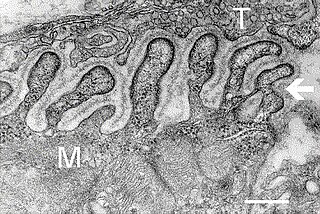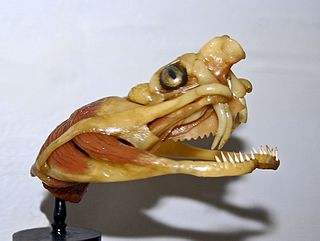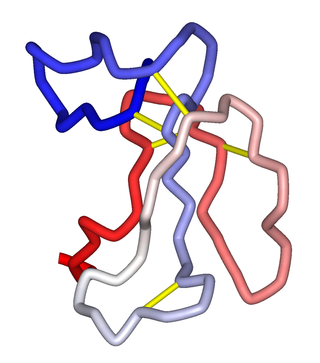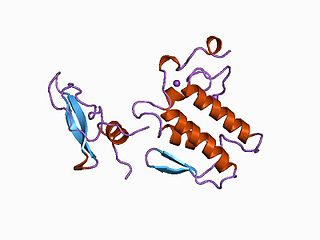Related Research Articles

Acetylcholine (ACh) is an organic compound that functions in the brain and body of many types of animals as a neurotransmitter. Its name is derived from its chemical structure: it is an ester of acetic acid and choline. Parts in the body that use or are affected by acetylcholine are referred to as cholinergic.

Neurotoxins are toxins that are destructive to nerve tissue. Neurotoxins are an extensive class of exogenous chemical neurological insults that can adversely affect function in both developing and mature nervous tissue. The term can also be used to classify endogenous compounds, which, when abnormally contacted, can prove neurologically toxic. Though neurotoxins are often neurologically destructive, their ability to specifically target neural components is important in the study of nervous systems. Common examples of neurotoxins include lead, ethanol, glutamate, nitric oxide, botulinum toxin, tetanus toxin, and tetrodotoxin. Some substances such as nitric oxide and glutamate are in fact essential for proper function of the body and only exert neurotoxic effects at excessive concentrations.

Bungarus is a genus of elapids native to Asia. Often found on the floor of tropical forests in South Asia, Southeast Asia and Southern China, they are medium-sized, highly venomous snakes with a length typically not exceeding 2 metres. These are nocturnal ophiophagious predators which prey primarily on other snakes at night, occasionally taking lizards, amphibians and rodents. Most species are with banded patterns acting as a warning sign to their predators. Despite being considered as generally docile and timid, kraits are capable of delivering highly potent neurotoxic venom which is medically significant with potential lethality to humans. The genus currently holds 16 species and 5 subspecies.

A neuromuscular junction is a chemical synapse between a motor neuron and a muscle fiber.

Nicotinic acetylcholine receptors, or nAChRs, are receptor polypeptides that respond to the neurotransmitter acetylcholine. Nicotinic receptors also respond to drugs such as the agonist nicotine. They are found in the central and peripheral nervous system, muscle, and many other tissues of many organisms. At the neuromuscular junction they are the primary receptor in muscle for motor nerve-muscle communication that controls muscle contraction. In the peripheral nervous system: (1) they transmit outgoing signals from the presynaptic to the postsynaptic cells within the sympathetic and parasympathetic nervous system, and (2) they are the receptors found on skeletal muscle that receive acetylcholine released to signal for muscular contraction. In the immune system, nAChRs regulate inflammatory processes and signal through distinct intracellular pathways. In insects, the cholinergic system is limited to the central nervous system.

Snake venom is a highly toxic saliva containing zootoxins that facilitates in the immobilization and digestion of prey. This also provides defense against threats. Snake venom is injected by unique fangs during a bite, whereas some species are also able to spit venom.

The cricothyroid muscle is the only tensor muscle of the larynx aiding with phonation. It is innervated by the superior laryngeal nerve. Its action tilts the thyroid forward to help tense the vocal cords.

α-Bungarotoxin is one of the bungarotoxins, components of the venom of the elapid Taiwanese banded krait snake. It is a type of α-neurotoxin, a neurotoxic protein that is known to bind competitively and in a relatively irreversible manner to the nicotinic acetylcholine receptor found at the neuromuscular junction, causing paralysis, respiratory failure, and death in the victim. It has also been shown to play an antagonistic role in the binding of the α7 nicotinic acetylcholine receptor in the brain, and as such has numerous applications in neuroscience research.
Taipoxin is a potent myo- and neurotoxin that was isolated from the venom of the coastal taipan Oxyuranus scutellatus or also known as the common taipan. Taipoxin like many other pre-synaptic neurotoxins are phospholipase A2 (PLA2) toxins, which inhibit/complete block the release of the motor transmitter acetylcholine and lead to death by paralysis of the respiratory muscles (asphyxia). It is the most lethal neurotoxin isolated from any snake venom to date.
Flaccid paralysis is a neurological condition characterized by weakness or paralysis and reduced muscle tone without other obvious cause. This abnormal condition may be caused by disease or by trauma affecting the nerves associated with the involved muscles. For example, if the somatic nerves to a skeletal muscle are severed, then the muscle will exhibit flaccid paralysis. When muscles enter this state, they become limp and cannot contract. This condition can become fatal if it affects the respiratory muscles, posing the threat of suffocation. It also occurs in the spinal shock stage in complete transection of the spinal cord occurring in injuries such as gunshot wounds.

α-Cobratoxin is a substance of the venom of certain Naja cobras. It is a nicotinic acetylcholine receptor (nAChR) antagonist which causes paralysis by preventing the binding of acetylcholine to the nAChR.

β-Bungarotoxin is a form of bungarotoxin that is fairly common in Krait venoms. It is the prototypic class of snake β-neurotoxins. There are at least five isoforms, coded β1 to β5, assembled from different combinations of A and Bchains.

α-Neurotoxins are a group of neurotoxic peptides found in the venom of snakes in the families Elapidae and Hydrophiidae. They can cause paralysis, respiratory failure, and death. Members of the three-finger toxin protein family, they are antagonists of post-synaptic nicotinic acetylcholine receptors (nAChRs) in the neuromuscular synapse that bind competitively and irreversibly, preventing synaptic acetylcholine (ACh) from opening the ion channel. Over 100 α-neurotoxins have been identified and sequenced.

κ-Bungarotoxin is a protein neurotoxin of the bungarotoxin family that is found in the venom of the many-banded krait, a snake found in Taiwan. κ-Bungarotoxin is a high affinity antagonist of nicotinic acetylcholine receptors (nAChRs), particularly of CHRNA3; it causes a post-synaptic blockade of neurotransmission. Although there is significant variability in the clinical effects of snake bites, neuromuscular paralysis and respiratory failure are associated with krait bites.

Fasciculins are a class of toxic proteins found in certain snake venoms, notably some species of mamba. Investigations have revealed distinct forms in some green mamba venoms, in particular FAS1 and FAS2 Fasciculins are so called because they cause intense fasciculation in muscle fascicles of susceptible organisms, such as the preferred prey of the snakes. This effect helps to incapacitate the muscles, either killing the prey, or paralysing it so that the snake can swallow it.

Three-finger toxins are a protein superfamily of small toxin proteins found in the venom of snakes. Three-finger toxins are in turn members of a larger superfamily of three-finger protein domains which includes non-toxic proteins that share a similar protein fold. The group is named for its common structure consisting of three beta strand loops connected to a central core containing four conserved disulfide bonds. The 3FP protein domain has no enzymatic activity and is typically between 60-74 amino acid residues long. Despite their conserved structure, three-finger toxin proteins have a wide range of pharmacological effects. Most members of the family are neurotoxins that act on cholinergic intercellular signaling; the alpha-neurotoxin family interacts with muscle nicotinic acetylcholine receptors (nAChRs), the kappa-bungarotoxin family with neuronal nAChRs, and muscarinic toxins with muscarinic acetylcholine receptors (mAChRs).
Mipartoxin-I is a neurotoxin produced by Micrurus mipartitus, a venomous coral snake distributed in Central and South America. This toxin causes a neuromuscular blockade by blocking the nicotinic acetylcholine receptor. It is the most abundant component in the venom.
Long neurotoxin 1 (LNTX-1) is a neurotoxin that binds antagonistically to all types of muscular and neuronal nicotinic acetylcholine receptors. LNTX-1 is found in the venom of the king cobra.
Crotoxin (CTX) is the main toxic compound in the snake venom of the South American rattlesnake, Crotalus durissus terrificus. Crotoxin is a heterodimeric beta-neurotoxin, composed of an acidic, non-toxic and non-enzymatic subunit (CA), and a basic, weakly toxic, phospholipase A2 protein (CB). This neurotoxin causes paralysis by both pre- and postsynaptic blocking of acetylcholine signalling.
References
- ↑ Kullmann, Florenta Aura; Chet de Groat, William; Artim, Debra Elaine (2009-01-01), Jankovic, Joseph; Albanese, Alberto; Atassi, M. Zouhair; Dolly, J. Oliver (eds.), "35 - Bungarotoxins", Botulinum Toxin, Philadelphia: W.B. Saunders, pp. 425–445, ISBN 978-1-4160-4928-9 , retrieved 2021-12-25
- ↑ Bungarotoxins at the U.S. National Library of Medicine Medical Subject Headings (MeSH)
- 1 2 Kullmann, Florenta Aura; Chet de Groat, William; Artim, Debra Elaine (2009-01-01), Jankovic, Joseph; Albanese, Alberto; Atassi, M. Zouhair; Dolly, J. Oliver (eds.), "35 - Bungarotoxins", Botulinum Toxin, Philadelphia: W.B. Saunders, pp. 425–445, ISBN 978-1-4160-4928-9 , retrieved 2021-12-25
- ↑ Chang C (1999). "Looking back on the discovery of alpha-bungarotoxin". J. Biomed. Sci. 6 (6): 368–75. doi:10.1159/000025412. PMID 10545772. S2CID 84443027.
- ↑ Chu N (2005). "Contribution of a snake venom toxin to myasthenia gravis: the discovery of alpha-bungarotoxin in Taiwan" (PDF). Journal of the History of the Neurosciences. 14 (2): 138–48. doi:10.1080/096470490881770. PMID 16019658. S2CID 20028814.
- ↑ Nirthanan, Selvanayagam (2020-11-01). "Snake three-finger α-neurotoxins and nicotinic acetylcholine receptors: molecules, mechanisms and medicine". Biochemical Pharmacology. Pharmacology and Therapeutic Potential of Venom Peptides. 181: 114168. doi:10.1016/j.bcp.2020.114168. ISSN 0006-2952. PMID 32710970. S2CID 220773156.
- 1 2 3 4 "Snakebite envenoming". www.who.int. Retrieved 2021-12-25.
- ↑ Kullmann, Florenta Aura; Chet de Groat, William; Artim, Debra Elaine (2009-01-01), Jankovic, Joseph; Albanese, Alberto; Atassi, M. Zouhair; Dolly, J. Oliver (eds.), "35 - Bungarotoxins", Botulinum Toxin, Philadelphia: W.B. Saunders, pp. 425–445, ISBN 978-1-4160-4928-9 , retrieved 2021-12-25
- 1 2 3 4 Kullmann, Florenta Aura; Chet de Groat, William; Artim, Debra Elaine (2009-01-01), Jankovic, Joseph; Albanese, Alberto; Atassi, M. Zouhair; Dolly, J. Oliver (eds.), "35 - Bungarotoxins", Botulinum Toxin, Philadelphia: W.B. Saunders, pp. 425–445, ISBN 978-1-4160-4928-9 , retrieved 2021-12-25
- 1 2 Nirthanan, Selvanayagam (2020-11-01). "Snake three-finger α-neurotoxins and nicotinic acetylcholine receptors: molecules, mechanisms and medicine". Biochemical Pharmacology. Pharmacology and Therapeutic Potential of Venom Peptides. 181: 114168. doi:10.1016/j.bcp.2020.114168. ISSN 0006-2952. PMID 32710970. S2CID 220773156.